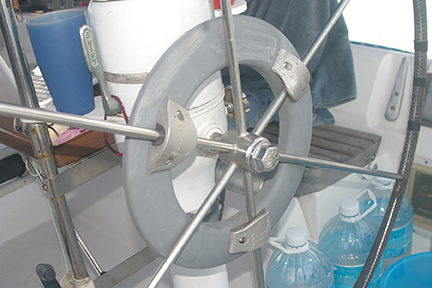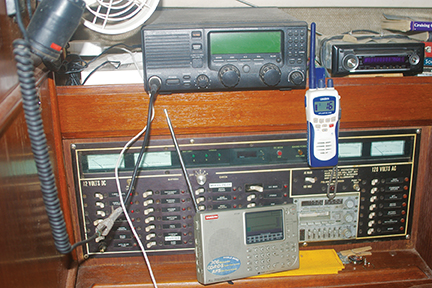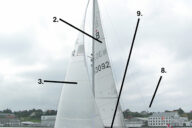Here’s a helpful article from John Champion on how to make your boat’s systems truly reliable…
Cruising boats are simple but contradictory things: a heap of essential, often complex, systems that you rely on for transportation, comfort and safety. Failure of a critical system at the best of times can be expensive and inconvenient. Experience the same failure at the worst of times and money may be the least of your problems. Round the world singlehanded racing types seem to have the right idea in duplicating all possible essential systems. Autopilot fails in the Southern Ocean? No worries, flick a couple of switches and its business as usual.
REAL RELIABILITY
Reliability isn’t about equipment lasting forever, because everything wears out or fails eventually and new gear is decidedly suspect until proven over time. Reliability is not about fixing things. The ability to quickly regain normal operation by changing over to a back up averts or at least delays a potentially critical situation. As long as the failed system can be repaired or replaced before the substitute packs it in, all remains well in your world.
Although it is hard to argue with such a philosophy, reality usually demands a tribute. Numerous factors will combine to ensure we are never fully equipped with all the redundant systems of choice, as this would demand two identical boats. Yacht size and expense are perhaps the major limitations. A 30-footer simply may not have the space to carry twice as much gear and few people will be able to afford the considerable cost of duplicating expensive equipment. Ultimately it remains a personal choice as to what is considered essential and what is optional. Very few people would ever leave port if everything had to be perfect. Some, but certainly not all, items to consider are sails, engine, steering, water, electricity, anchoring, navigation, communications and cooking.
STEERING
This is one item that truly deserves a backup and most cruisers seem to agree given the number of boats that have at least two self-steering methods. Windvanes are very popular and many swear by them, although a few hate their guts. They consume no power and some models will function as an auxiliary rudder, which is sufficient reason alone to want one. These are often hooked to a small electric tiller pilot that allows the unit to steer to a compass course rather than following only the apparent wind. Wheel and tiller pilots are small, above deck electric units that utilize the boats existing steering gear. These are often undersized (especially wheel pilots) for offshore work, and as a consequence of the excessive workload are prone to failure.
 A major drawback of wheel pilots and some windvanes is that they use the boat’s existing steering mechanism (cable, gears etc) so any failure of this puts you out of action. If you have ever tried to steer using an emergency tiller for any length of time, that expensive below deck autopilot fixed to the rudderpost or quadrant starts to sound like a bargain. Additionally, this system removes the load from steering gear when operating, making failure less likely. In an ideal world each boat would come with two identical (so they can be cannibalized for parts if needed) complete below deck pilots fixed to the rudderpost, a windvane with auxiliary rudder capacity, and a wheel or tiller pilot as the last refuge of the damned.
A major drawback of wheel pilots and some windvanes is that they use the boat’s existing steering mechanism (cable, gears etc) so any failure of this puts you out of action. If you have ever tried to steer using an emergency tiller for any length of time, that expensive below deck autopilot fixed to the rudderpost or quadrant starts to sound like a bargain. Additionally, this system removes the load from steering gear when operating, making failure less likely. In an ideal world each boat would come with two identical (so they can be cannibalized for parts if needed) complete below deck pilots fixed to the rudderpost, a windvane with auxiliary rudder capacity, and a wheel or tiller pilot as the last refuge of the damned.
ENGINE
There is not much you can do about this unless you have a catamaran or some kind of super yacht. Regular service and frequent attention are the best bet. The ability to hand start the engine is desirable but is generally only possible on smaller diesels. Redundancy for a diesel comes down to carrying enough spare parts to keep the engine running. Commonly carried spares include a starter motor, water pump, alternator, regulator, fuel pump, injectors and the usual assortment of belts, impellers, hoses, filters and gaskets. Some cruisers who carry a decent sized outboard have devised brackets on the stern to allow them to be used as a backup.
ANCHORING
Staying put in the place of your choice is an important issue and many people, sensibly, take their anchors seriously. A large anchor—at least one pound per foot of boat length—with lots of all chain rode will do as a primary and a couple of spares with sufficient rode are necessary. Carry only one spare anchor and you will feel pretty naked if the primary goes missing. Whatever you use it should be relatively easy to deploy and importantly, easy to retrieve. This is where the choice of windlass becomes crucial. If you are the windlass then a manual unit sounds good but there is no substitute for electric. If the power fails you should be able to operate the winch manually, some will be better than others in this respect. If everything fails try using a sheet winch and system of lines to raise the anchor, or just pull it up by hand. A yacht with crew makes the best redundant system in this case.

COOKING SYSTEMS
Forget to fill the spare gas bottle and all of a sudden you’re looking at six weeks of cold soup. So rather than burning the furniture consider another method of cooking. If you have a BBQ on board, and who doesn’t these days, see if it can be used with a different fuel source from the galley stove. Microwaves will do it if you have the electricity, and a lightweight camping butane stove that many offshore racers use will get you out of trouble. Cooking food on the hot engine is very expensive unless you’re motoring anyway.
THE RIG
This is another essential one. Lose the rig and the shine goes right out of the day. There is no substitute for a professional inspection and replacement of suspect or excessively aged components. Some cruisers replace the wire with the next size up and others may add additional stays. Twin masthead forestays would be a great comfort and running backstays will help keep the show on the road. Another thing to consider is carrying a long length of high-tech line such as Dyneema that can be spliced to any size and used as a spare stay if one were to break.
Halyards are well worth duplicating, having two each for the mainsail and jib plus spares for the spinnaker and staysail if you have them is essential. Mainsail preventers can be sized to double as spare headsail sheets and you will want a couple of spare blocks rattling around in the locker. Don’t forget the humble winch handle either, life under sail without one means blisters and flapping sails. If space allows, a spare spinnaker or whisker pole would be nice and provide the option of flying a dual headsail while running.
ELECTRICITY
It is hard to have too much of this on board, most don’t have enough energy and are dependent on an engine or generator to get it. Assuming your yacht has an auxiliary diesel, at the very least you need a smart regulator and decently sized alternator. But alternate energy generation is worth the effort and expense. The complimentary relationship between wind generators and solar panels illustrates the point of redundancy well. Rare is the day that it is both heavily overcast and without wind; usually one or the other is putting out for the batteries and saving fuel. Rely solely on a genset and sooner or later the main engine will be picking up the load while you try to find someone on the other side of the world who can fix it.
COMMUNICATION AND NAVIGATION
 This is where it gets high-tech and potentially, like all the rest, very expensive. The options on communication gear alone could set you back the price of a 40-foot boat. Satellite domes that put the world of cable TV into the saloon and all the facilities of the head office straight into the nav station are available for a price. Assuming this stuff, with the high purchase outlay and considerable usage charges are part of the problem, not the solution, marine radio is probably the way to go. A High Frequency transceiver is an excellent solution for long-range communications. With an HF radio you can communicate between boats and get voice weather forecasts and receive weather faxes and emails if you have a computer and modem. Another option is to carry a satellite phone that can also be hooked into your computer and will allow you make voice calls, at a price of course.
This is where it gets high-tech and potentially, like all the rest, very expensive. The options on communication gear alone could set you back the price of a 40-foot boat. Satellite domes that put the world of cable TV into the saloon and all the facilities of the head office straight into the nav station are available for a price. Assuming this stuff, with the high purchase outlay and considerable usage charges are part of the problem, not the solution, marine radio is probably the way to go. A High Frequency transceiver is an excellent solution for long-range communications. With an HF radio you can communicate between boats and get voice weather forecasts and receive weather faxes and emails if you have a computer and modem. Another option is to carry a satellite phone that can also be hooked into your computer and will allow you make voice calls, at a price of course.
A less expensive solution for weather forecasts is to receive only short wave radio. These cost a couple of hundred dollars and will provide voice weather forecasts, receive weather faxes and make a good spare in case the main unit lets you down. A VHF radio is often sufficient for coastal cruising and every boat needs a good one. A handheld makes a great backup, but is not a substitute for the extra power and antenna height of a base station.
Navigation options are many. Chartplotters are a marvelous invention and significantly more robust, convenient (if mounted in the cockpit) and weather proof than laptop computers running a nav program. Many people use both and it is rare to find a voyaging boat without at least one computer these days. A computer/laptop combination will provide some redundancy, but never forget the paper charts and handheld GPS. Also, make a note of where the sextant is stowed. Having both tricolor and deck level lights is an easy way to duplicate navigation lights. This way no one is going up the mast at sea to change a burnt out bulb.
SAILS
These are the things your engine is supposed to be backing up, which is why they call it an auxiliary. The thing to remember about sails is to buy the best you can afford from a reputable sail maker, not someone who makes white triangles in between furniture upholstering jobs. If a sail is not worth using, it’s not worth having aboard. Big, heavy furling genoas may be the mainstay of a cruising boat but can be either too heavy (light wind full sail) or too big (strong wind partially furled sail) so think about what you really need when the next sail order comes around. Naturally, having a couple of spare sails is always going to be handy, but consider, if you have just blown out your best jib, what chance does the 20-year-old patchwork quilt have? An extra mainsail would be nice if there was room on board, but it’s better to keep the existing one in a single piece. Have at least three reefs and don’t be afraid to use them, reef early, reef deep and with luck you will have a sail to bequeath to the grandkids.
WATER
There are two issues to consider with water, keeping it in and getting it out. Fresh water needs to be kept safe and accessible and bilge water pumped out. Multiple tanks are best for your fresh water for a number of reasons. If a tank breaks free, leaks or is contaminated then all is not lost; simply switch to the next tank and hope it is not empty. Always keep an emergency stash of drinking water sufficient for the time between refills and never rely on a single source. If long passages are the plan this may not be possible, which is where a watermaker may fill the gap. Numerous tanks will also spread the weight around the boat and will probably equate to better trim. Most boats have electric water pumps to power the taps. At least one manual pump is needed in case the power or pump fails. Bilge pumps are also mostly electric, but oversized manual backups are non-negotiable. Consider when you are most likely to need a bilge pump and there is no argument.
It has been said that optimists see the glass as half full while pessimists see the same glass as half empty. Being pessimistic means you will want redundant systems for your boat and once this is done you’ve earned the right to be optimistic.
John Champion has lived aboard since 1999 and sailed half way around the world in the process. He currently floats around in Langkawi, Malaysia and offers appraisals and surveys for production boats in the region. If you are thinking of buying over that way he can be contacted at, jwchampion@live.com.au














